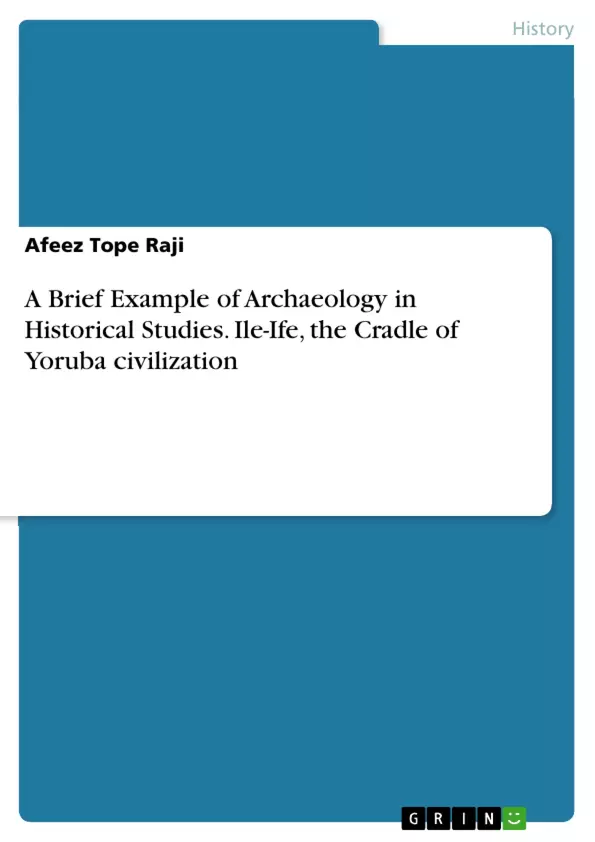This essay aims to give a short introduction into the discipline of Archeology and its distinction from History. The thrust of this piece is on the contributions of this all important venture to the historical reconstruction of Ile-Ife, Nigeria, the cradle of Yoruba civilization.
Archeology as a discipline, as distinct from history but complementary to it, has played a facultative role in the historical reconstruction of preliterate societies overtime. The thrust of this piece is on the contributions of this all-important venture to the historical reconstruction of Ile-Ife, the cradle of Yoruba civilization. The fact that history deals with the past in time perspective, understandably makes it peremptory for the historical researcher to approach its study from a multidisciplinary perspective: Hence, Archeology.
Table of Contents
- Introduction
- Archaeology: A Conceptualization
- Archaeology and the History of Ile-Ife
Objectives and Key Themes
This text aims to explore the contribution of archaeology to the historical reconstruction of Ile-Ife, the cradle of Yoruba civilization. It examines the conceptualization of archaeology as a discipline and its application in understanding pre-literate societies.
- The definition and conceptualization of archaeology.
- The role of archaeology in reconstructing the history of Ile-Ife.
- Archaeological findings in Ile-Ife and their interpretations.
- Limitations of archaeological data in historical reconstruction.
- The interplay between archaeology and oral traditions.
Chapter Summaries
Introduction: This introductory section establishes the central argument of the text: archaeology's crucial role in reconstructing the history of pre-literate societies, specifically focusing on Ile-Ife, the origin of Yoruba civilization. It highlights the multidisciplinary nature of historical research and emphasizes the complementary relationship between archaeology and history in understanding the past. The introduction sets the stage for a detailed exploration of archaeological contributions to the understanding of Ile-Ife's history, acknowledging the limitations inherent in archaeological interpretations.
Archaeology: A Conceptualization: This chapter delves into the definition and conceptualization of archaeology. It presents various scholarly definitions, highlighting the lack of a single universally accepted definition. The chapter explores how different scholars, including Stuart and McManamon, Fagan, Odunbaku, and White, conceptualize archaeology—from the study of ancient things to the study of past ways of life using various research methods and interpretive techniques. It underscores the multifaceted nature of archaeological inquiry and the diverse approaches to understanding past human behaviors and societies through material remains.
Archaeology and the History of Ile-Ife: This chapter focuses on the application of archaeology to the historical reconstruction of Ile-Ife. It discusses significant archaeological discoveries in Ile-Ife, including findings at sites like Lafogido, Odo Ogbe, Obalara, and Wumonije. The chapter details the excavation processes, interpretations of findings (such as the "pit and pot" burial practice), and the contributions of various archaeologists like Ekpo Eyo, William Fagg, K.C. Murray, Bernard Fagg, Oliver Myers, and Frank Willet. The narrative weaves together accounts of both planned excavations and accidental discoveries, showcasing the diverse ways in which archaeological data has enriched our understanding of Ile-Ife's past. The chapter also acknowledges challenges and limitations in interpreting the findings, such as the potential for misinterpretations and the impact of the material's durability on what can be unearthed.
Keywords
Archaeology, Ile-Ife, Yoruba civilization, historical reconstruction, pre-literate societies, material culture, excavation, interpretation, limitations of archaeological data, oral traditions.
Frequently Asked Questions: A Comprehensive Language Preview
What is the main focus of this text?
This text focuses on the contribution of archaeology to the historical reconstruction of Ile-Ife, considered the cradle of Yoruba civilization. It explores how archaeology helps us understand pre-literate societies.
What topics are covered in the text?
The text covers the conceptualization of archaeology as a discipline, its application in understanding Ile-Ife's history, significant archaeological findings in Ile-Ife and their interpretations, the limitations of archaeological data, and the interplay between archaeology and oral traditions.
What are the key themes explored?
Key themes include the definition and conceptualization of archaeology, the role of archaeology in reconstructing Ile-Ife's history, the analysis of archaeological findings in Ile-Ife (including specific sites like Lafogido, Odo Ogbe, Obalara, and Wumonije), the challenges and limitations of interpreting archaeological data, and the relationship between archaeological evidence and oral traditions.
What is the structure of the text?
The text is structured into an introduction, a chapter on the conceptualization of archaeology, and a chapter specifically dedicated to the application of archaeology to the history of Ile-Ife. It also includes a table of contents, objectives and key themes, chapter summaries, and keywords.
Which archaeologists are mentioned in the text?
The text mentions several key archaeologists whose work has contributed to the understanding of Ile-Ife, including Ekpo Eyo, William Fagg, K.C. Murray, Bernard Fagg, Oliver Myers, and Frank Willet. It also discusses the contributions of scholars like Stuart and McManamon, Fagan, Odunbaku, and White regarding the conceptualization of archaeology.
What are some of the archaeological findings discussed?
The text discusses archaeological discoveries in Ile-Ife, including details about excavation processes and interpretations of findings, such as the "pit and pot" burial practice. Specific sites mentioned include Lafogido, Odo Ogbe, Obalara, and Wumonije.
What are the limitations of archaeological data acknowledged in the text?
The text acknowledges potential misinterpretations of archaeological findings and the impact of the material's durability on what can be unearthed as limitations of archaeological data in historical reconstruction.
How does the text address the relationship between archaeology and oral traditions?
The text highlights the interplay between archaeological findings and oral traditions as complementary sources of information in reconstructing the history of Ile-Ife.
What are the keywords associated with this text?
Keywords include Archaeology, Ile-Ife, Yoruba civilization, historical reconstruction, pre-literate societies, material culture, excavation, interpretation, limitations of archaeological data, and oral traditions.
What is the intended audience for this text preview?
This text preview is intended for academic use, supporting the analysis of themes in a structured and professional manner.
- Quote paper
- Afeez Tope Raji (Author), 2020, A Brief Example of Archaeology in Historical Studies. Ile-Ife, the Cradle of Yoruba civilization, Munich, GRIN Verlag, https://www.grin.com/document/515157



